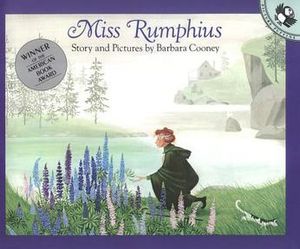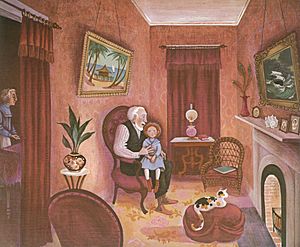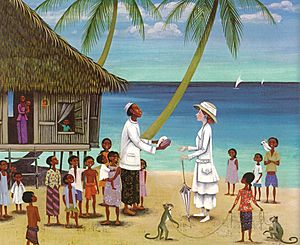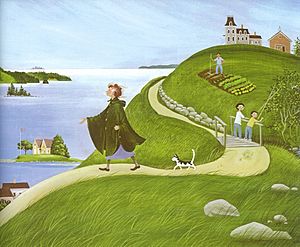Miss Rumphius facts for kids

Front Cover of Miss Rumphius
|
|
| Author | Barbara Cooney |
|---|---|
| Illustrator | Barbara Cooney |
| Country | United States |
| Language | English |
| Genre | Picture book |
| Publisher | Viking Press |
|
Publication date
|
November 1982 |
| Media type | Print (hardcover) |
| Pages | 32 pp (first edition) |
| ISBN | 978-0-14-050539-9 |
| OCLC | 12724739 |
| [E] 19 | |
| LC Class | PZ7.C783 Mi 1985 |
Miss Rumphius is a picture book for children written and illustrated by Barbara Cooney and first published by Viking Books in 1982. It features the life story of fictional Miss Alice Rumphius, a woman who sought a way to make the world more beautiful and found it in planting lupines in the wild. Miss Rumphius was inspired by the real life "Lupine Lady," Hilda Hamlin, who spread lupine seeds along the Maine coast, as well as Cooney's own experiences traveling the world.
Cooney and William Steig (Doctor De Soto) shared the 1983 National Book Award for Children's Books in the hardcover Picture Books category. Based on a 2007 online poll, the National Education Association listed the book as one of its "Teachers' Top 100 Books for Children." In 2012 it was ranked number 13 among the "Top 100 Picture Books" in a survey published by School Library Journal. The Lupine Award of the Maine Library Association is named in honor of this book, as is the New Jersey Center for the Book's Miss Rumphius Award given to librarians and teachers who develop creative activities to support literacy education.
Plot
The book opens with the narrator telling readers about a little old woman nicknamed "The Lupine Lady" who "lives in a small house overlooking the sea." The story of her Great Aunt, Miss Rumphius, begins to unfold, starting when her aunt was just a little girl named Alice.
In illustrations depicting the late 1800s, a young Alice lives with her grandparents near a waterfront shipping town. Her grandfather, an immigrant who arrived by boat to America himself, now carves the figureheads for sailing ships in his old age. At night, he regales his granddaughter with stories of exotic places across the sea. Inspired, Alice tells her grandfather that, when she grows up, she will travel to faraway places and settle down by the sea when she grows old, just as he did. He agrees that her plans are "all very well," but goes on to tell her that she must do one more thing: "You must do something to make the world more beautiful." Alice resolves to follow her grandfather's advice, though she is not sure how.
For a time, life goes on normally and, eventually, Alice grows up. She goes to work in a library where people call her Miss Rumphius and she helps them find books they're looking for. It is in the library where she learns about more faraway places. Time continues to pass and streaks of gray appear in her hair.
In her spare time, she likes to visit the local conservatory where she can linger among the exotic plants and dream of the places from which they originally came. She decides she finally needs to go see those places for herself.
Her first trip abroad takes her to Indonesia where she befriends the king of a fishing village. From there, she goes on to climb snowy mountains, trek through jungles, and walk across deserts as she travels to many of the faraway places she promised herself she would go. While traveling in the "Land of the Lotus-Eaters" (Tunisia in North Africa), however, she hurts her back getting off a camel and decides that it's time to find her place by the sea.
After returning to America and settling into a cottage overlooking the water, Miss Rumphius—an older woman now—begins to wonder how she might accomplish the final task her grandfather told her she must do to "make the world more beautiful," but her back injury worsens and, for some time, it is unclear if she will be able to complete the task. As she rests and tries to recover, she reflects on how much she loves the lupines outside her bedroom window, and, after discovering a patch of them farther along the cliffs near her home, she realizes how she can accomplish her third and final goal.
She sends off for as many lupine seeds as she can acquire and begins scattering them all over her community—along cliffside roads, near buildings in town, along stone walls, and in hollows between hills. People who see her think she's crazy, but the following spring, it becomes clear she accomplished her goal; her community is bursting with colorful lupines growing everywhere and she has made the world more beautiful.
The story concludes with the young narrator (who we learn is also named Alice) telling readers that her great Aunt Alice is now very old—so old that local children drop by her home to see who they believe is the oldest woman in the world. She tells them stories of her faraway adventures. As in the beginning, the young Alice tells her she would like to see the world when she grows up and "come home to live by the sea." But just as Miss Rumphius' own grandfather did before her, the elder Alice reminds the younger of the third thing she must yet do—"something to make the world more beautiful." And, much like her great aunt when she was her age, the young narrator admits that she does "not yet know what that can be."
Adaptations
A film adaptation of Miss Rumphius was made by Spellbound Productions, Inc. and Weston Wood Studios in 2000. The film was directed by Sarah Kerruish and narrated by Claire Danes. The film is about 16 minutes long and it is available as a video in Spanish and English. The film won the UNICEF Prize at the 2002 Barcelona International TV and Video Festival as well as a Bronze Plaque at the 2001 Columbus International Film and Video Festival.




